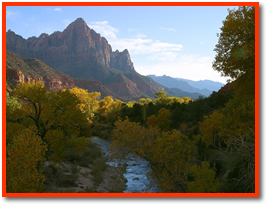 Zion
National Park welcomes almost three million visitors each
year who come to enjoy the stunning landscapes and towering
red rock cliffs. The first inhabitants of Zion National Park
were the Anazasi and later the Paiute Native Americans. The
first white settlers to the area were Mormon Pioneers. These
settlers gave Zion canyons and formations bible names. Zion
itself is an ancient Hebrew word that stands for place of peace
and refuge. As you visit the immense canyons of the beautifully
sculptured rock formations, soaring cliffs and breathtaking
landscapes you will agree that Zion National Park certainly
lives up to its name. Zion
National Park welcomes almost three million visitors each
year who come to enjoy the stunning landscapes and towering
red rock cliffs. The first inhabitants of Zion National Park
were the Anazasi and later the Paiute Native Americans. The
first white settlers to the area were Mormon Pioneers. These
settlers gave Zion canyons and formations bible names. Zion
itself is an ancient Hebrew word that stands for place of peace
and refuge. As you visit the immense canyons of the beautifully
sculptured rock formations, soaring cliffs and breathtaking
landscapes you will agree that Zion National Park certainly
lives up to its name.
Zion National Park was first established in 1909 as Mukutuweap
National Monument and was later expanded to its present day
size of 229 square miles and renamed. Zion provides endless
opportunities for enjoying and exploring nature. Zion is well
known for its incredible rock formations and is home to Kolob
Arch, which is the largest arch in the worlds spaning 310
ft. Zion is also famous for its deep slot canyons. One of
these canyons, The Narrows, attracts hikers from all around
the world. Zion National Park is located at the junction of
the Colorado Plateau, Great Basin and Mojave Desert. This
unique geography provides Zion with an unusual diversity of
plant and animal life.
Quick Facts:
Size: 229 square miles
Lowest Elevation: 3,666 ft., Coal Pits Wash in the southwest corner
Highest Elevation: 8,726 ft., Horse Ranch Mountain in the Kolob Canyons section
Visitation: In 1920: 3,692; in 1996: 2.5 million
Weather:
Spring weather is an unpredictable combination of wet, stormy days and warm sunny ones.
Spring wildflowers bloom from April to June.
Summer days are hot with temperatures varying between 95-110 F. At night it cools down to 65-75 F. Afternoon
thunderstorms are common from mid-July through September, producing waterfalls and causing flash floods.
Autumn is usually clear and mild. Autumn color displays begin in September and peak in late October.
Winter weather is fairly mild. Temperatures range between 40-60 F during the day and 20-30 F at night. Storms bring
rain or snow and sometimes cause the roads to be icy.
|